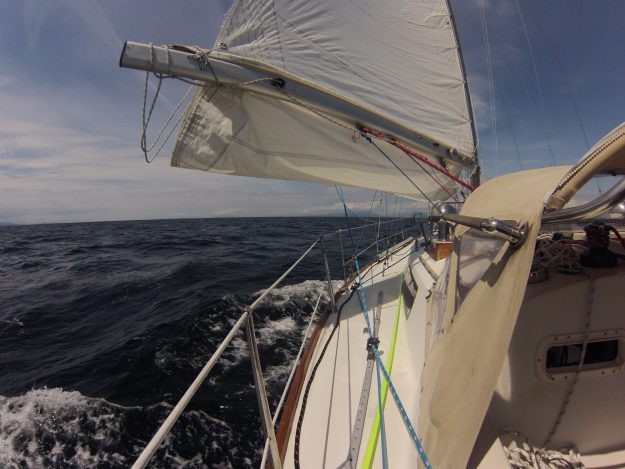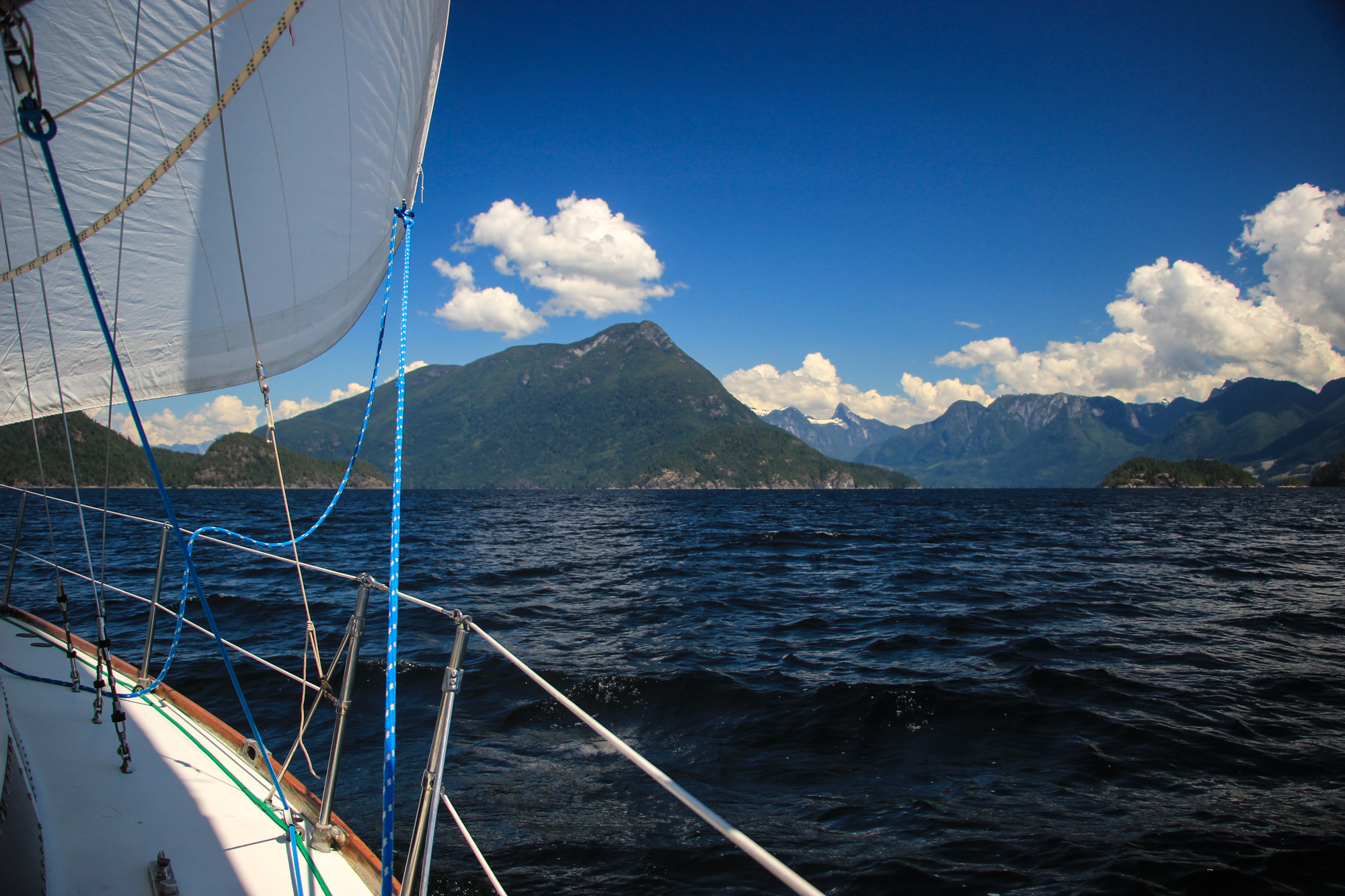[This article was published in the June 2017 issue of 48 North magazine. But it’s never been published online, and some readers here may not have seen it. Plus it’s a good reminder to us of our priorities as we sail north!]
Newcomers to sailing might think that sailors spend the majority of their time covering ground under sail, solely moving by the power of the wind. Experienced coastal cruisers – those who travel from port to port – know this is usually far from reality. The Pacific Northwest is notorious for light, fickle winds in the summer months.
In between major marinas, it’s often more common to see a sailboat motoring than sailing. The time of year is coming where I’ll see sailboats motoring upwind into a perfect sailing breeze of 10 knots or so, and even sailboats motoring downwind with a light following wind. Essentially, a lot of cruisers are traveling to a schedule. Plus, for many cruisers, sailing in the PNW is a Goldilocks problem – the wind is always too low or too high, never just right.

Certainly there’s nothing wrong with motoring if that’s your choice, but if you’re determined to cruise the PNW by sail power, there can be great rewards to it:
- Earth-friendly. Sailing uses no fossil fuels while you’re traveling on wind power alone.
- Cheap. Sailing is pocket book friendly too – diesel costs money, and sailing costs very little (the wear and tear on the sails, per mile, is minuscule – especially if you run your cruising sails to their last legs).
- More wildlife. Sea life doesn’t come around a boat running a noisy diesel engine with a spinning prop that could cut them to tiny bits. By sailing more, you have more occasions where porpoises play in your bow wake, seals approach closer, and bears on shore don’t run away when you’re hundreds of feet away.
- Being less reliant on your engine. After our transmission died a slow death on our first cruise, I’ve never felt comfortable being completely reliant on having auxiliary power. Sailing more pushes us to increase our sailing skills and occasionally do things like sail onto and off of anchor.
Last summer we sailed our C&C Landfall 38 over 1300 nautical miles in 3 months time using an average of only 5 gallons of diesel per week. We sailed from Seattle, through the San Juans and Gulf Islands, the Sunshine Coast, Desolation Sound, the Broughtons, and Queen Charlotte Strait, then back to the South Sound and Seattle. About 75% of the mileage was covered under sail.

In 3 months time, many people choose to go to Alaska, and cover more mileage with a whole lot more motoring. But their sail-to-motor ratio reverses, to as high as 90%, 95% or more in motoring. On the other hand, traveling a high percentage of your miles by sail usually means accepting less audacious distance goals. But we were very happy with our decision to prioritize slow paced sail-based cruising over always pushing to further destinations.
There were numerous tips and tricks we learned along the way to make it easier. For starters, a healthy disregard for conventional wisdom helped. We were told people don’t sail the Inside Passage, that the wind would always be on our nose, and the idea of sailing up narrow straits like Johnstone Strait was considered laughable. All those things weren’t true, and we sailed both upwind and downwind in Johnstone Strait and many other straits. About 50% of our sailing mileage was downwind.

To be a sailing cruiser, a few prerequisites make it more likely to work out:
- Time plus an enormous amount of patience. Modern society doesn’t cultivate this – we get impatient if our YouTube video doesn’t buffer within a couple seconds, or if we have to wait more than a few minutes at a stoplight. Sailing in light and fluky winds for hours at a time requires tremendous patience, and this is a skill that gets stronger through practice.
- Both of you (if you’re a cruising couple, or otherwise everyone onboard) must be motivated to sail rather than motor. If only one person is into it, the other person will get frustrated and vote for motoring.
- Have a boat with good sailing performance, both upwind and downwind. You can do it with a slow, heavy boat, but this is going to make it much harder. 60% of our sailing time last summer was in light wind (4-10 knots).
The boats best suited for sailing full-time in the PNW are performance oriented and sail upwind like they were born for it. You should be able to move over 2 knots in 5 knots true wind on a close haul to beam reach. - It’s more than just the type of boat though – it must be set up for easy sailing. It took us over a year before our boat was a well oiled sailing machine. Make sure you have a reefing system that is easy and quick, smooth low friction blocks so raising sails is low effort, and know sail configurations for every level of wind.

Over the last two years we’ve developed a strategy for maximizing sailing:
1) Plan short passages. Preferably no more than 20 nautical miles between anchorages. If you have great wind and are making good time you can shoot for further – plan B. But planning on long days (ex, over 40 miles) is the biggest thing likely to require you motor.
2) Routing based on the wind. A big part of our strategy was heavily integrating the wind into our routing. On a daily and weekly basis we planned our route and destinations to improve our chances of finding good wind. If southerlies were coming, which are fairly rare in the PNW summer, we’d go north as far as we could to use that following wind.
3) The 15 minute rule. We have a 15 minute rule – if the wind has died and we’re moving less than 2 knots for 15 minutes, we can turn on the engine. We don’t always do so, but the 15 minute rule allows either of us to declare a starting point when we’re getting tired of slowly drifting, and helps ensure we don’t give up too quickly. Sometimes the wind comes back up after only 5 minutes, but 5 minutes can feel like a really long time when you’re drifting at 1.4 knots with the sails eager to luff.

4) If there’s wind up, we *GO*. If you wake up to 10 knots in your anchorage or marina in the morning, you go as soon as possible. The wind dictates your schedule, not your social plans or normal routine.

5) Flexible schedules and timing. If the wind wants you to reverse direction or stay put, why not revisit a place you’ve already been, or spend a day at anchor? Having plans to meet up with friends or crew can make this one tricky. That’s why cruisers have the expression “you can pick the time or place, but not both.”
6) Stay close to sailable corridors. Sailable corridors are the areas of the PNW that have wind. This one requires more experience with local waters, but if you can, don’t sail (or motor) yourself into a corner. We try to avoid going up long narrow inlets (like Jervis Inlet to Princess Louisa) unless we’re really sure the destination is worth it.
The Strait of Georgia and northern Puget Sound are good examples of a sailable corridor. The ideal anchorage along a sailable corridor is often an outside anchorage – for example, Cabbage Island on the outside of the Gulf Islands allows you to quickly get out to the Strait of Georgia on a light wind day, or duck into the Gulf Islands on a high wind day.

This year we’re heading out to the west coast of Vancouver Island, and hope to do something we’ve never done – sail, at least part of the way, out the Strait of Juan de Fuca.
[That was last year (2017). In 2018 we’re already underway in early April and hope to maximize our use of southerlies to get north as far as Haida Gwaii before turning around in late June]
